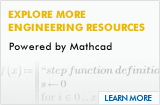
Belt Drive Design
View animation - 21 Kb
Description
This example illustrates how Behavioral Modeling can be used to automate complex belt drive design to achieve better solutions. The application unlike any other previous example and spans a broad range of industries, as many types of products require the design of a belt drive.
The general process for designing a belt drive consists of selecting a safety factor, calculating the design horsepower, and selecting the belt pitch, center distance, sprocket combination, belt length, and belt width. The resulting design is then evaluated for qualities such as serviceability, efficiency, and compactness.
Without Behavioral Modeling an engineer must go through a great deal of trial-and-error design to fit standard part pulleys and belts to the desired belt drive design. This process is considerably automated with Behavioral Modeling. Analysis features are created to capture the length of the belts, clearance between pulleys, and the amount of wrap on each pulley. Analysis features also capture relations such as the pulley speed ratio and drive output speed. The results for a given belt length are then easily obtained through a feasibility study. Several independent feasibility studies can be performed for varying belt lengths and then evaluated and compared relative to compactness requirements, for example. If it is desired to experiment with another pulley combination, family tables can be utilized to make the change quickly and a follow-up feasibility study for a desired belt length performed. With design exploration and solution identification so well automated, many more belt drive designs can be tested and a better final design discovered.
